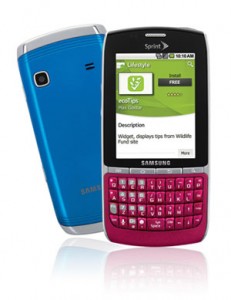Green Gadget of the Week: Samsung Replenish smartphone (from Sprint)

(This is the latest in a regular weekly series of spotlights on green technology that's accessible to you and me. If you have a product to suggest for coverage, please send a note via my contact email.)
I always find it difficult to "review" mobile phones because the fact of the matter is that I need people to be able to call me when I'm on the run, and I'm not about to give out a temporary phone number. Too confusing. But I jumped at the chance to play around for a couple of weeks with the new Samsung Replenish, which is being billed as the greenest smartphone around.

Back to the phone, which is an Android 2.2-based slim bar phone gadget that includes a 2.8-inch QVGA touch screen (lots of pixelation) and small QWERTY keypad for input.
It has all the bells and whistles you would expect in an inexpensive smart phone, such as a respectable 2-megapixel camera and camcorder, Wi-Fi network support and a MicroSD card slot that can handle cards up to 32 megabytes.
I make it a rule to try not to use manuals when I look at products, because who really studies the manuals (if one even comes in the box). That said, I found the interface and settings relatively easy to use if, even if I have been horribly spoiled by iPhone navigation expectations and its great screen quality. The "touch" on the Replenish keyboard was easy enough to navigate, since the keys have little contour bubbles, although I imagine that people with larger thumbs than mine might find it awkward. Frankly, I've become so used to soft keyboards that this one took some getting used to.
The phone itself measures 4.84 inches by 2.36 inches by 0.45 inches. It weighs slightly more than four ounces. Samsung claims that the phone gets talk time of about 5.4 hours, with standby time of more than 212 hours. I didn't push the phone to the limit, so I can't verify those numbers, although I did find that I charged it about as often as my own phone (an Apple iPhone 4).
One of the more unusual features you'll find is an optional snap-on cover (an extra $29) that doubles as a solar charger. Frankly, I installed the charger but was unable to easily figure out how much the charger was helping to extend the battery life. At one point, it appeared to be drawing power. Later on, though, no luck. Still, I love the idea and with some finagling, I could probably figure out a workaround. I would love to see this, or other alternative charging options on more smartphones in the future since they suck up so much power.
Because this is a green gadget review, I'll focus on those specifications:
- Approximately 35 percent of the case is made from post-consumer recycled plastic content
- 82 percent of the components in the device itself can be recycled at the end of life
- The gadget is free of "intentionally added" polyvinyl chloride, brominated flame retardants, phthalates or beryllium
- The charger meets rigorous criteria for energy efficiency, and there is a visual alert that tells you when the phone is fully charged
- The packaging is recyclable and also refreshingly minimal
Replenish comes preloaded with links to content and applications that explore green and environmental issues, called the Green ID pack. I poked around those applications a bit. They are aimed primarily at those seeking green lifestyle tips. Very consumer-focused, although there is also a green business news service.
The phone feels solid, although when I removed the cover to install the solar panel, it felt a bit flimsy and I was afraid I might crack it. When I walked around my house and drove around my town making a few calls, it performed admirable, especially compared to my own iPhone. (I live in Northern New Jersey, because I know that geographic location is always a factor in network performance.)
The phone carries a price of $49.99 if you agree to a two-year contract; Sprint has waived its traditional $10 data plan premium in order to entice users. The phone currently comes in two colors, Arctic Blue and Onyx Black; a Raspberry Pink version was supposed to be out in June, but when I visited the Sprint Web site while writing this review, it wasn't available yet.
Past Green Gadgets of the Week: